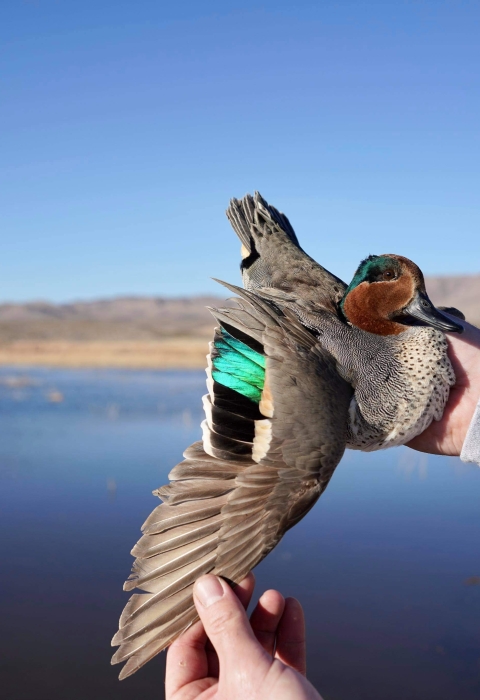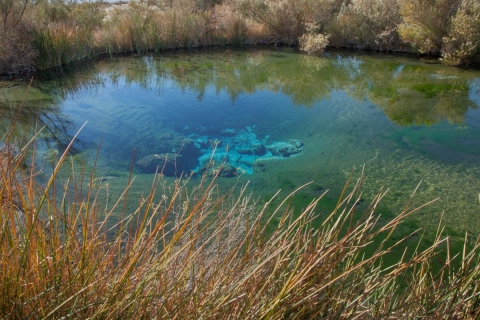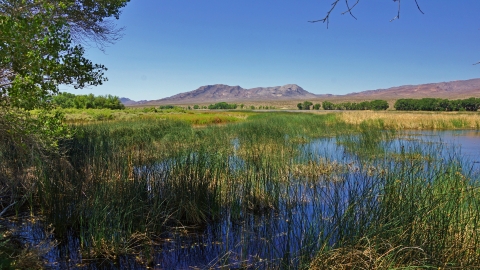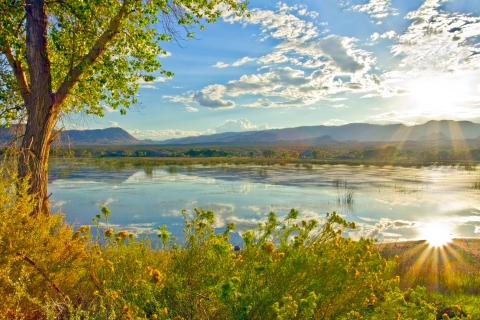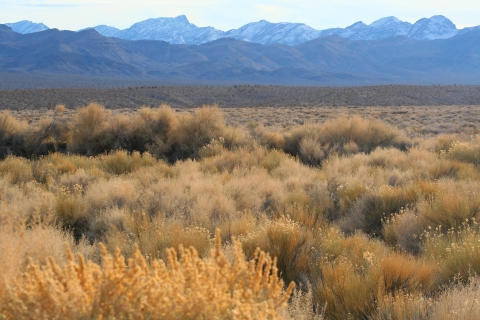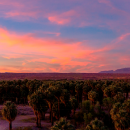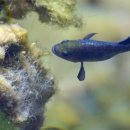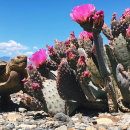About Us
The Nuwuvi (Southern Paiute and Chemehuevi) oral history and the geologic record indicate that thousands of years ago Nevada was much cooler and wetter than it is today. Many valleys contained lakes which dried up as the climate warmed, leaving white mineral deposits on valley and canyon walls. Today, Pahranagat National Wildlife Refuge (NWR) contains several lakes and marshes, similar to those which once occurred throughout many parts of southern Nevada. In the Paiute language, Pahranagat can mean “feet sticking in water,” an apt name for this wetland oasis straddling the Mojave and Great Basin Deserts. Few landscapes are as contrasting as Pahranagat National Wildlife Refuges lush wetlands and the surrounding desert landscape. Nourished by life-giving waters of Crystal and Ash Springs, Pahranagat NWR offers wetland and riparian riparian
Definition of riparian habitat or riparian areas.
Learn more about riparian habitats for thousands of migratory birds, numerous birds of prey, deer, reptiles, small mammals, and rare fish.
Visitors from near and far find sanctuary among the crystal pools and springs as they learn about the Refuge's unique plant and animal communities. Local people take pride in the Refuge, and visitors tell their families and friends about this brilliant desert gem. Educators recognize the Refuge as an exceptional regional resource for environmental education and observation of wildlife and the habitats upon which they depend. Volunteers take great personal satisfaction from applying their interests and abilities to the conservation and interpretation of a unique, natural Mojave Desert community for the enjoyment of present and future generations of Americans.
Pahranagat NWR is one of more than 560 refuges in the National Wildlife Refuge System, a network of lands set aside specifically for wildlife. Managed by the U.S. Fish and Wildlife Service, the System is a living heritage, conserving wildlife and habitat for people today and generations to come.
Our Mission
The mission of the National Wildlife Refuge System is to administer a national network of lands and waters for the conservation, management and, where appropriate, restoration of the fish, wildlife and plant resources and their habitats within the United States for the benefit of present and future generations of Americans. However, every national wildlife refuge national wildlife refuge
A national wildlife refuge is typically a contiguous area of land and water managed by the U.S. Fish and Wildlife Service for the conservation and, where appropriate, restoration of fish, wildlife and plant resources and their habitats for the benefit of present and future generations of Americans.
Learn more about national wildlife refuge was created for a special purpose. Some were created to protect migratory birds, others to protect threatened or endangered species, while other refuges may be fulfilling another special purpose or protecting unique habitats. All activities allowed on refuges must be evaluated to make sure each activity will not conflict with the reason the refuge was founded.
At Pahranagat National Wildlife Refuge the purpose of our conservation efforts is to maintain the riparian riparian
Definition of riparian habitat or riparian areas.
Learn more about riparian and wetland habitats for migrating birds, including the critically endangered Southwestern Willow Flycatcher. The Refuge works to manage the available natural resources on the refuge for the benefit of migratory birds and other wildlife that can be found here.
Our History
In 1963, the U.S. Fish and Wildlife Service recognized the value of the Pahranagat Valley and designated 3,916 acres of lakes, marshes, meadows, and desert uplands as Pahranagat NWR. Later land acquisitions expanded the refuge to its present size of 5,382 acres. Pahranagat NWR is located on the Pacific Flyway, a major north-south migratory route along the western coast of the United States. Hundreds of birds stop here to rest and refuel during their long journeys. In the spring and fall, the migration of hundreds of unique bird species makes Pahranagat a birdwatcher's paradise. Many bird species also breed and overwinter here.
Today...
The Pahranagat National Wildlife Refuge is managed as a sanctuary where present and future generations of people can discover a connection to the rhythms of life. In spring, indigo bush and beavertail cactus bloom at the edges of verdant meadows and wetlands, fed by brimming lakes. The vital, spring-fed waters of this Mojave Desert oasis attract thousands of migratory birds each year. Pahranagat NWR’s seasonal marsh, wet meadows, and alkali flats provide high quality resting and foraging habitat for wintering and migrating waterfowl, shorebirds and other waterbirds along the Pacific Flyway. Riparian gallery forests of willow, cottonwood, and associated plant communities support a flourishing population of the endangered southwestern willow flycatcher as well as a rich diversity of migratory and resident songbirds, colonial nesting species, and birds of prey. Coveys of Gambel’s quail emerge at dusk along with abundant cottontails and jackrabbits as nighthawks, coyotes, and owls begin to hunt. Each fall brings returning waterfowl and waterfowl hunters, while mountain lions follow mule deer down into the valley.
Pahranagat NWR’s recreational opportunities will bring visitors into close proximity with wildlife. There have been 264 bird species recorded on the refuge, which is over half of all birds recorded in the state of Nevada! Visitors also have the opportunity to experience five different habitats all in one afternoon here at the Refuge.
Pahranagat's Habitats
Lakes and Wetlands
Large thermal springs north of the town of Alamo provide water for lakes and wetlands, a rare and precious habitat in southern Nevada. Water is stored in Upper Pahranagat Lake and released as needed to nurture habitats in the central and southern portions of the refuge. Upper Pahranagat Lake and the North Marsh Lake, which have the deepest water, attract diving ducks such as canvasbacks, common mergansers, and ruddy ducks. The shallower Middle Marsh and Lower Pahranagat Lake are preferred by dabbling mallards, pintails and cinnamon teal as well as wading herons and egrets. Northern harriers, marsh wrens, yellow headed blackbirds, muskrats, and even the occasional bald eagle or peregrine falcon, also benefit from marsh habitats. Seasonal draining of marshes exposes mudflats, a prime feeding area for white faced ibis, American avocet, and killdeer.
Riparian Habitat
Cottonwood and willow trees line the refuge’s lake shores and springs. Riparian habitats (a word that refers to moisture-dependent vegetation that grows along watercourses) are among the most endangered habitats in the Southwest. Riparian habitat provides feeding and nesting areas for birds that migrate here from the tropics, such as the yellow warbler, Bullock’s oriole, and the endangered southwestern willow flycatcher. Nonnative tamarisk (salt cedar) trees, which add toxic salts to soils and use large quantities of valuable ground water, are removed, as are Russian olive trees.
Meadows
Moist meadows are home to many rodent species. These small mammals provide food for raptors and coyotes. Refuge staff irrigate meadows to provide green forage for sandhill cranes, waterfowl and wading birds. Meadows and other grasslands are sometimes burned or mowed to remove old plants and stimulate new growth.
Desert Uplands
Since the refuge straddles both the great Basin and Mojave Desert, a diversity of upland plants grows here, including sagebrush sagebrush
The western United States’ sagebrush country encompasses over 175 million acres of public and private lands. The sagebrush landscape provides many benefits to our rural economies and communities, and it serves as crucial habitat for a diversity of wildlife, including the iconic greater sage-grouse and over 350 other species.
Learn more about sagebrush , saltbush, creosote, and yucca. They provide shelter and food for reptiles and small mammals, which are hunted by coyotes, raptors and roadrunner.
Other Facilities in this Complex
Pahranagat National Refuge is part of Desert National Wildlife Refuge Complex. Desert National Wildlife Refuge Complex consist of four Wildlife Refuges: Ash Meadows National Wildlife Refuge, Moapa National Wildlife Refuge, Desert National Wildlife Refuge, and Pahranagat National Wildlife Refuge.
